Keep scrolling to view Mr. Cianci's necktie collection...
A great big KNOT thank you and flip of the tie to Mr. Cianci for his swell tips on rejuvenating our Nasty Old Ties....
![]()
In both cases, the tiesí edges simply pulled apart or dissolved while being cleaned with the harsh chemicals dry cleaners use every day. To find out more about the dry cleaning process (so I wouldnít sound like a know-nothing as I wrote this article), I spoke to a few dry cleaners, all of who swore by a substance called perchlorethylene, which is the standard cleaning agent dry cleaners use. Lately though, a few cleaners here in northwest NJ have started using a less toxic petroleum-based substance that is supposedly environmentally friendly, not to mention milder and gentler on delicate fabrics.
So, whatís the alternative? You can buy a product called Dryel that will allow you to dry clean in the privacy of your own home. Itís a bit pricey at about $10.99, and I have yet to try it. More on that another time.
Or, you can send your ties out to a company in New York City called Tie Crafters, which specializes in cleaning, repairing and manufacturing custom ties. They charge a hefty $7.00 to clean any tie, $12.00 for repairs, and $17.00 to clean and repair any tie. Is it expensive? Maybe, but what are your alternatives? Many tailors donít want to be bothered fixing ties. Tie Crafters require payment upfront, as well as shipping costs both to and from their locations. Visit their web site at www.tiecrafters.com for complete information. Iím going to try them.
However, if you decide to use a local dry cleaner to clean your nasty old ties, ask a lot of questions first. Discuss the situation with the dry cleaner and ascertain whether or not he or she has a feel for cleaning vintage clothing. Check out different cleaners until you find one you feel comfortable with; someone who understands vintage clothing and the special care they require.
In my case, I found Nick Ciccone, owner of Riverside Dry Cleaners in Hackettstown, NJ. We discussed the problems I was having with old silk ties, and hereís what he said. ďIíve been in this business for thirty years. I can tell you that it wasnít the perchlorethylene that ruined your ties; it was the agitating motion of the dry cleaning machine during the extraction cycle. Silk ties have to be placed inside a dry cleaning bag suitable for delicates before they go into the machine. Second, the ties have to be removed just as the extraction cycle reaches its zenith. Otherwise, you run the risk of them being torn apart.
ďYou also have to consider the condition of the tie before you bring it in to be dry cleaned. Silk is a natural fiber that breaks down after a certain amount of time and use. If the tie is a little shaky to start with, a little frayed around the edges, chances are it wonít survive dry cleaning. If you have ties that are slightly damaged, I recommend you do not dry-clean them. Hang them on the wall instead and admire them as they are. ďI look over every garment that might be a risk and advise the customer before I take on the responsibility of cleaning their old clothing. I once had a customer who brought in a very old dress that was in no shape for dry cleaning, but she insisted I give it a try. Sure enough, it fell apart and she was very upset. I tried to talk her out of itĒ With this info, I decided to give Nick a try and brought him three old silk ties to clean. One of them did fray slightly at the tip, and the fabric separated about one half of the way up from the bottom. If I tie the tie properly, the hole wonít show. The other two, both of which contained multiple sweat and food/drink stains, came out much better than I expected. They are now wearable.
So, it appears I have at last found a good dry cleaner with some knowledge of cleaning vintage ties. I urge you to do the same. Just be very careful in selecting a dry cleaner and ask questions until you are satisfied. It is always preferable to speak directly to the owner or the person who actually does the cleaning. One final warning: Dry cleaning nasty old silk ties is a risky proposition no matter how competent or sincere the dry cleaner may be.
Good luck.
By Bob Cianci
Note: the author bears no responsibility for the outcome of readersí experiences dry cleaning old silk ties.
......................................................................................................................................................
Years ago, I was faced with this dilemma countless times and after trying dry cleaning with less than satisfactory results, decided to try something crazy. I filled the sink with cold water, added a capful of Woolite, held my breath, and plunged my newly purchased 40ís floral tie right in. For all I knew, the colors could have run, ruining the tie, but it was a chance I had to take. After soaking it for about five minutes, I drained the water, rinsed the tie thoroughly with lukewarm water, carefully squeezed the excess water and hung it over the shower curtain bar to air dry. Next morning, the tie was immaculately clean. The stains were gone and the tie shone like it was brand new. All I did was press it lightly with a warm iron and it was ready to wear.
Yes, you can clean your own ties. Forget about dry cleaning. You can wash your rayon, crepe and satin 40ís ties just as I did. Hereís how.
Use Woolite and follow the directions on the back of the bottle. I always use cold water and at least an overflowing capful. Get a safety pin, turn the tie over and pin the two flaps together. This will keep the tieís shape intact while soaking. Stir the soap and water solution thoroughly and put your tie in. Depending upon the severity of the stains, let the tie soak for at least three to five minutes. You can soak the tie longer if necessary. I have actually walked away and left ties soaking for as long as a half hour. You can also pre- treat stains with Woolite prior to soaking. Pour a little Woolite directly on the stain brush lightly with an old toothbrush, and then dunk the tie in the solution after a few minutes.
When you are satisfied that the tie is clean, drain the Woolite and water solution and rinse the tie very thoroughly with warm water. Make sure you get all the soap out of the tie. Roll the tie into a flat square and squeeze the excess water out carefully. Donít worry. You wonít damage it!
Roll the tie back out and immediately place it over a towel rack or shower curtain bar. You can even hang it outside over the clothesline. With a paper towel, blot any remaining water from the tie. Hand-shape the tie into its proper shape. If you do this properly, you might be able to avoid ironing altogether. Continue to hand-shape if necessary, while the tie is drying. Let dry completely. Depending upon weather conditions, expect it to take at least several hours. I always let them dry overnight.
Next day, set your iron for a warm setting, not too hotÖand carefully iron the tie. Try not to iron it too flat, but this is difficult sometimes. You must make a choice: Do want a clean tie you can wear thatís a little too flat, or a dirty, stained piece of fabric you canít wear? I donít know about you, but Iíd rather have a clean, wearable, flat tie.
Thatís the process. It isnít brain surgery, but take your time at first and follow the directions on the Woolite bottle. You will find that better quality ties will keep their shape and clean up much better than then the eraís cheaper ties.
One word of caution: Do not try the Woolite cleaning procedure on silk ties! The colors will run and youíll ruin the tie completely. I speak from experience. Confine tie washing to rayon, crepe and satin ties.
Good luck and happy tie hunting.
By Bob Cianci
Bob Cianci has been collecting 1940ís ties for over fifteen years and has well over a 1200 ties at this time, preferring quality above quantity. Bobís specialty is art deco geometrics and he is always up for trading. When Bob is not hunting down vintage ties, he works in newspaper advertising, plays drums in several rock and blues bands, writes articles for music magazines, newspapers and web sites, and also collects old drums and guitars, 60ís rock, blues and r&b records, Civil War and WWII relics and memorabilia, old drum and automobile ads, die-cast cars, vintage model kits, Medieval artifacts and funky soda bottles. If you have 40ís art deco ties to trade or sell, please contact Bob at bcianci@tellurian.net.
*The author takes no responsibility for the outcome of tie cleaning as recommended by this article.
![]()
This is just a small representation of my collection, which now numbers approximately 1700 ties, most of which are 40's geometric deco ties. I also have two bins full of 90's deco and abstracts, perhaps the tie collectibles of the future, as well some skinny 50's and 60's ties which I may sell in the near future. I wear a 40's tie to work every day and they inevitably draw comments and compliments from co-workers and customers. This is a great hobby. How many people get to wear their collections on their chests? If anyone has 40's deco ties to trade or sell, please email me at bcianci@tellurian.net
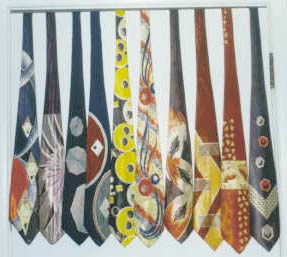

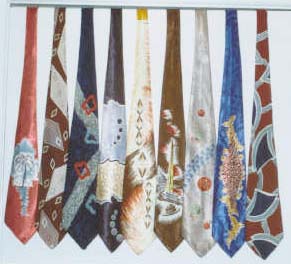
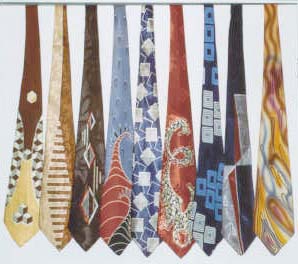
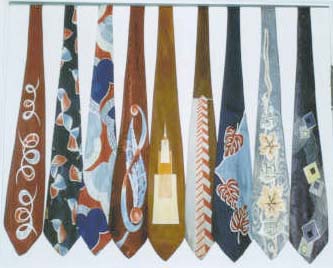
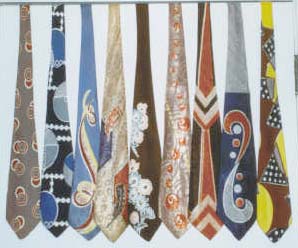
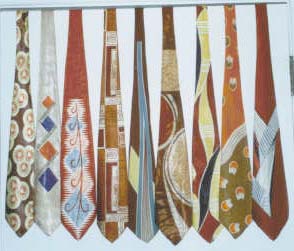
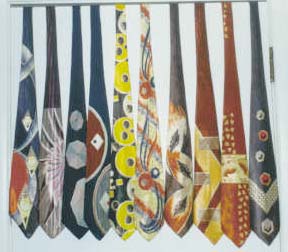
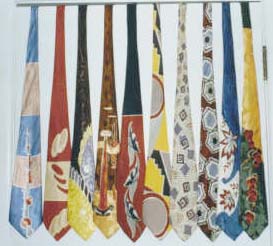
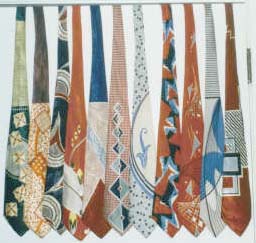
![]()